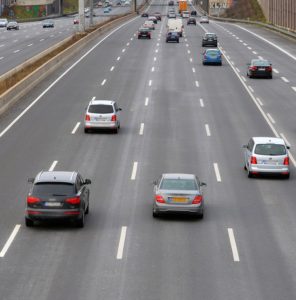 Courtesy of iii.org
Courtesy of iii.org
The cost and crashworthiness of vehicles as well as drivers safety habits affect the cost of auto insurance. Out of concern for public safety and to help reduce the cost of crashes, insurers support safe driving initiatives. The insurance industry is a major supporter of anti-drunk driving and seatbelt usage campaigns.
Lives saved by safety devices
- Airbags: Airbags are designed to inflate in moderate to severe frontal crashes. The National Highway Traffic Safety Administration (NHTSA) says that as of 2013 there were 202 million airbag-equipped passenger vehicles on the road in the United States, including 199 million with dual air bags. The agency says that frontal airbags saved 2,573 lives in 2015. Airbags, combined with seatbelts, are the most effective safety protection available for passenger vehicles. Seatbelts alone reduce the risk of fatal injury to front-seat passenger car occupants by 45 percent. The fatality-reducing effectiveness for frontal airbags is 14 percent when no seatbelt is used and 11 percent when a seatbelt is used in conjunction with airbags.
- Seatbelts: Among passenger vehicle occupants age five and older, seatbelts saved an estimated 13,941 lives in 2015. In fatal crashes in 2014, about 80 percent of passenger vehicle occupants who were totally ejected from the vehicle were killed. NHTSA says that when used seat belts reduce the risk of fatal injury to front seat passenger car occupants by 45 percent and the risk of moderate-to-critical injury by 50 percent. For light truck occupants, the risk is reduced by 60 percent and 65 percent, respectively.
- Child safety seats: NHTSA says that in 2015 the lives of an estimated 266 children under the age of five were saved by restraints.
- Motorcycle helmets: NHTSA estimates that helmets saved the lives of 1,772 motorcyclists in 2015. If all motorcyclists had worn helmets, an additional 740 lives could have been saved.
- Helmets are estimated to be 37 percent effective in preventing fatal injuries to motorcycle riders and 41 percent for motorcycle passengers. In other words, for every 100 motorcycle riders killed in crashes while not wearing a helmet, 37 of them could have been saved had all 100 worn helmets.
- Electronic stability control: The National Highway Traffic Safety Administration (NHTSA) requires all vehicles manufactured after model year 2012 to have electronic stability control (ESC). All new passenger cars, light trucks, SUVs and vans must comply with the requirement. ESC was designed to help prevent rollovers and other types of crashes by controlling brakes and engine power.
- NHTSA says ESC saved an estimated 681 passenger car occupant lives in 2014 and 899 lives among light truck and van occupants for a total of 1,580 lives saved among passenger vehicle occupants. The 2014 total for lives compares with 1,366 lives saved in 2013 and 1,225 lives saved in 2012. Over the five years from 2010 to 2014, NHTSA says the ESC has saved a total of more than 4,100 lives.
- NHTSA estimated that about 99 million 2006-model year and newer passenger vehicles (passenger cars and light trucks and vans) were equipped with ESC. This works out to 38.8 percent of the 255 million passenger vehicles on the road in 2014.
- In May 2014 NHTSA released a report on updated estimates of fatality reduction by electronic stability control (ESC), which found that in single-vehicle crashes of passenger cars, where the first harmful event was a rollover, ESC decreased rollovers by 59.5 percent, relative to a control group. The reduction in rollovers was even more dramatic in LTVs such as pickup trucks, SUVs and vans, 74 percent.
- In June 2010 the Insurance Institute for Highway Safety (IIHS) released the findings of a study that found that ESC for passenger vehicles is one of the most effective technologies for the prevention of fatal crashes, especially rollovers. IIHS data show that it lowers the risk of a deadly crash by 33 percent and cuts the risk of a single-vehicle rollover by 73 percent. The IIHS examined 10 years of crash data from NHTSA.
Motor vehicle crashes
2017: Traffic fatalities were 1 percent lower in the first six months of 2017, compared with the same period in 2016, according to preliminary estimates from the National Safety Council (NSC). The organization says the decline comes after the steepest estimated two-year increase in traffic deaths since 1964. In addition, the first six months’ tally for 2017 is 8 percent higher than the same period in 2015.
2016: According to data released by the National Safety Council (NSC), in 2016 there were more than 40,000 traffic fatalities in the U.S. for the first time in 10 years. The NSC statistics show a 6 percent increase in auto crash deaths in 2016, and a 3 percent rise in the number of miles Americans drove, compared with 2015. NSC estimates that the cost of deaths, injuries and property damage attributed to crashes in 2016 totaled $432.5 billion, up 12 percent from 2015. Nearly 4.6 million people required medical treatment after crashes, an increase of 7 percent over 2015.
2015: According to NHTSA, traffic fatalities rose 7.2 percent in 2015 to 35,092 people from 32,744 in 2014. In 2015 an estimated 2.44 million people were injured in motor vehicle crashes. The fatality rate per 100 million vehicle miles traveled in 2015 rose to 1.07 from 1.08 in 2014.